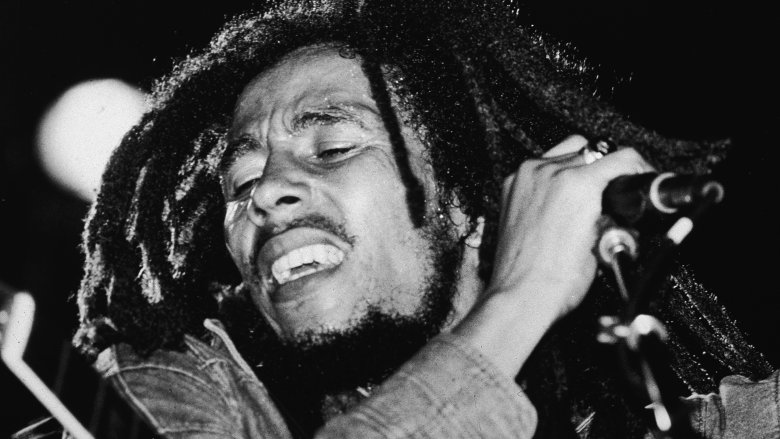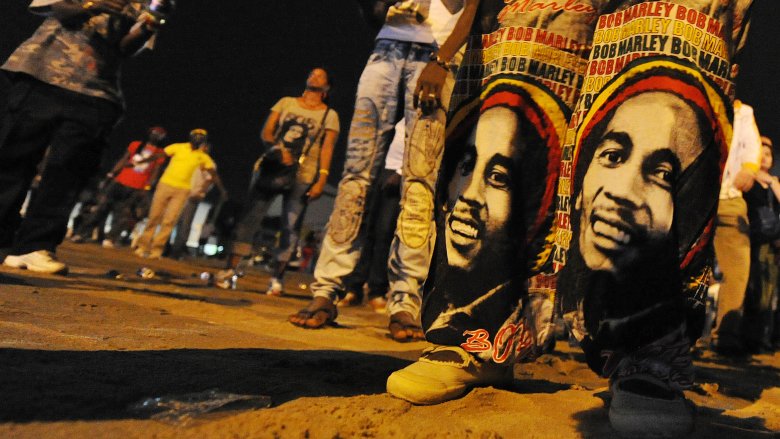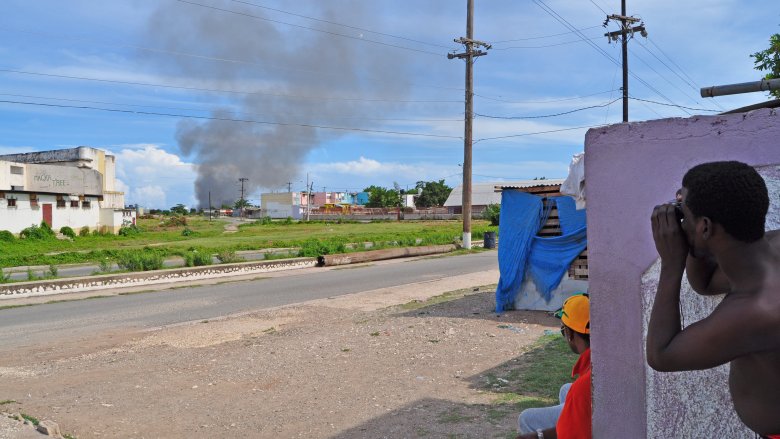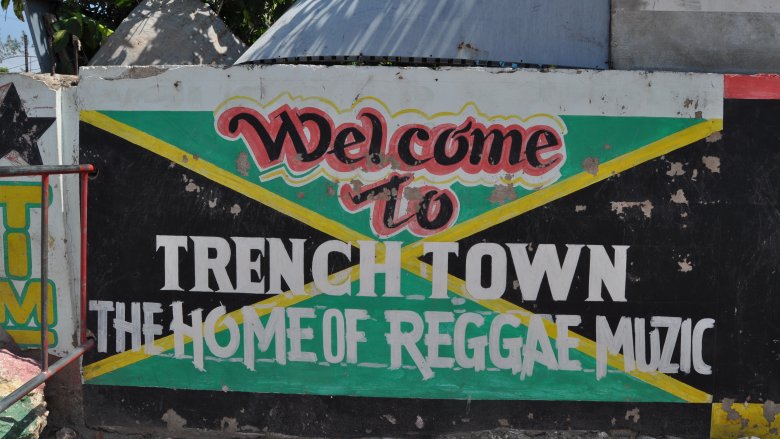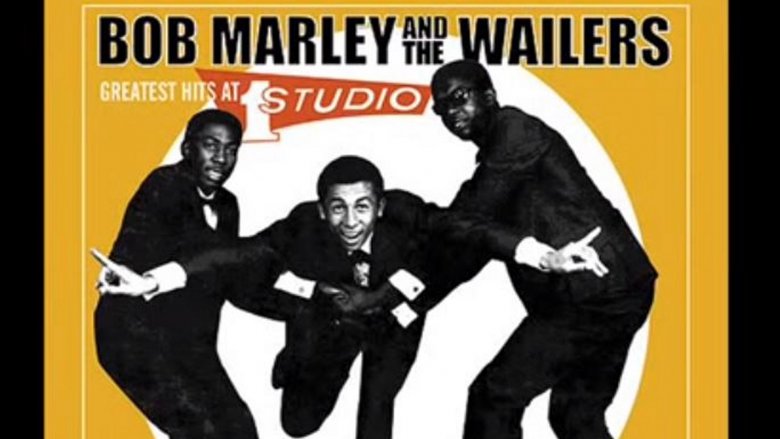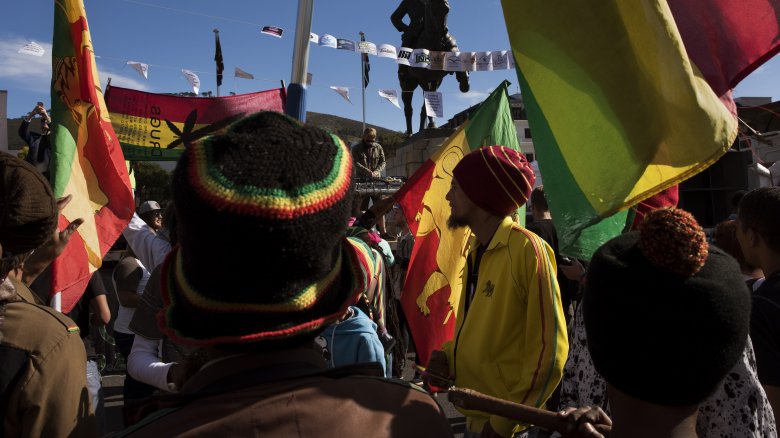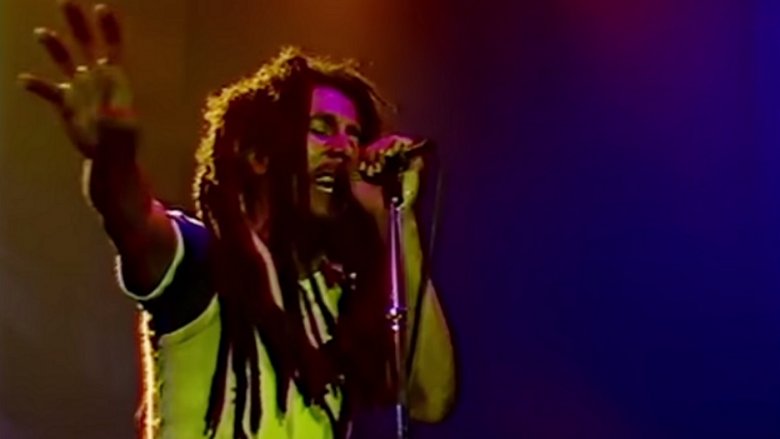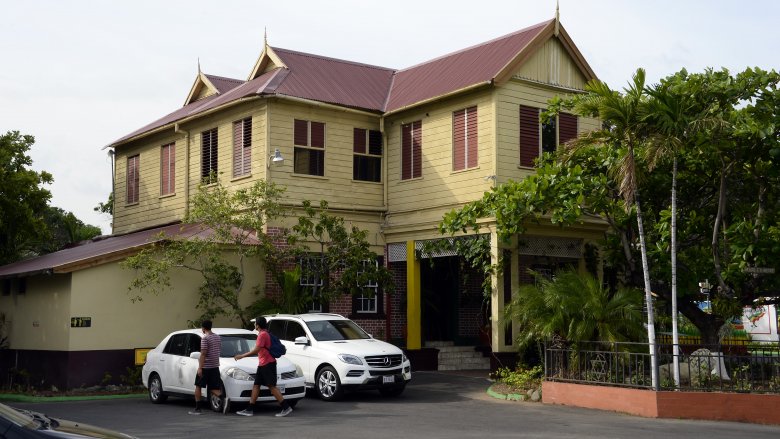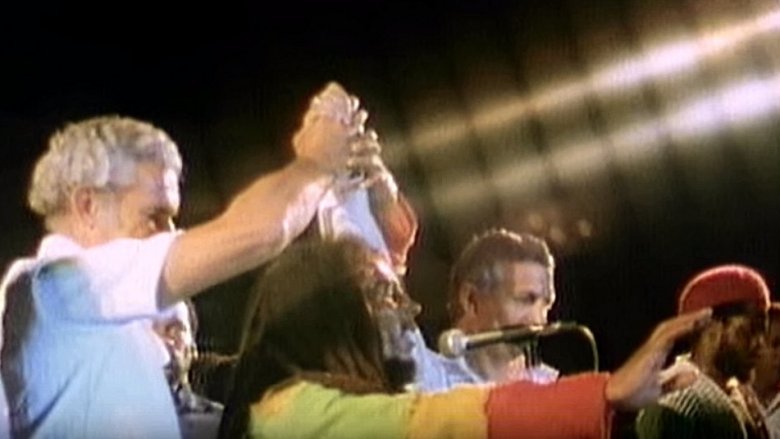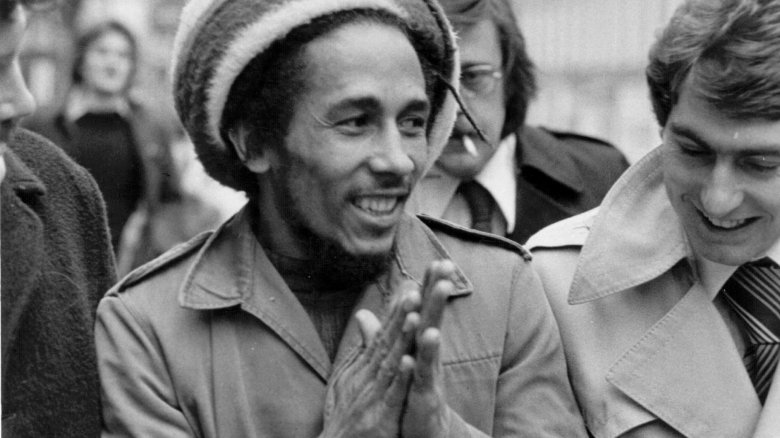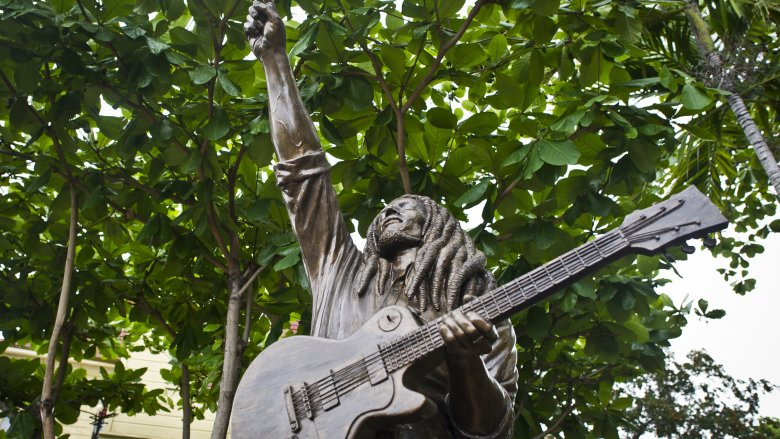Bob Marley's Tragic Real-Life Story
Few figures in history have inspired the world as much as Bob Marley. As an artist, his popularity is right up there with the Beatles and Led Zeppelin. But as a cultural icon? He might be even bigger. Between his distinctive dreadlocks, his unforgettable songs, and his undying loyalty to the island of his birth, Bob Marley will forever be memorialized as a proponent of peace, an advocate for truth, a trendsetter, and — above all else — a symbol of Jamaican pride.
However, while Bob Marley posters adorn the walls of countless college parties today, it would be a deep mischaracterization to pretend the actual Marley's life story was always happy, easy, or carefree. Bob Marley's strong political and religious beliefs were the product of growing up around turmoil and poverty. As a working class Rastafarian from Trenchtown who became a world famous musician, Marley faced countless challenges in his life, from systemic oppression to assassination attempts, an exile from his home, and finally a tragic bout with cancer. Throughout it all, he never stopped believing in his message, and that's why the world still celebrates Bob Marley today.
He had an absent father
The history of Jamaica is a tale of both oppression and rebellion, with slaves pitted against colonial subjugation. The origin of Bob Marley, according to Rolling Stone, was a microcosm of this bigger story. His mother was Cedella, a descendant of slaves, and his father was Captain Norval Sinclair Marley, a privileged white politician working for the British government. The power imbalance here would be obvious enough, but to make things worse, Cedella was only 17 years old.
With promises of marriage and economic stability, Norval Marley manipulated Cedella into a romantic relationship with him. Then, as soon as Cedella got pregnant, he hit the road. This left Cedella as a poor, single mother, pregnant with a child who would probably be severely ostracized for his mixed-race heritage. Determined to give her son the best life possible, Cedella left behind her home in the rural village of Nine Mile and made a new life in Kingston.
Cedella named her son Robert, and though Bob carried his father's surname, the famous singer never felt attached to the unknown man who had treated his mother so cruelly. According to the BBC, the adult Bob almost never spoke about his father, and never stopped being angry at him. As for Norval himself, he died when his son was only 10 years old.
Tuff Gong chills with the Rude Boys
Once they got to Kingston, Cedella and her son set up shop in the city's Trenchtown neighborhood, which Rolling Stone describes as one of Kingston's most economically disadvantaged areas. The Trenchtown "yard," as it was described, was composed of cheap corrugated metal shacks, usually without any plumbing. Conditions were harsh. Fights and stabbings were common. Everyone had to work hard to survive. During Bob Marley's youth, Trenchtown's street gangs grouped together into a bigger unit called the Rude Boys, a group that often got into violent battles with the local police force.
Bob Marley never considered himself a true member of the Rude Boys, and it's hard to imagine him being part of a gang, but he was comfortable hanging out with them. From an early age, he learned to stand up for himself, and even earned the street name "Tuff Gong." Years later, he used this old moniker as the name of his recording studio, according to the Washington Post.
Trenchtown was 'the Motown of Jamaica'
To truly understand Bob Marley, you have to understand Trenchtown. Marley never rejected his Kingston roots, according to Rolling Stone. While others could have looked into those streets and seen nothing but crime, poverty, and pain, Marley witnessed bravery, strength, and a sense of community. He didn't want to escape Trenchtown — he wanted to show Trenchtown to the world and to help improve the quality of life for the neighbors he'd grown up with.
It's no coincidence that Bob Marley's creativity was fueled by the place he grew up. According to Biography, Trenchtown was considered the Motown of Jamaica, with several of the country's most popular musicians calling it home. Though Marley had learned to play guitar at an early age, alongside his childhood friend Neville "Bunny" O'Riley Livingston, it was in his teens and early 20s that he really erupted as a musical force. Marley's first efforts as a solo artist didn't quite strike gold, but big things started happening quickly once he and his friends put together a band.
The Wailers are born
According to Biography, the so-called "Wailing Wailers" finally came together in 1963, when Marley, Livingston, and their new friend Peter McIntosh (later shortened to Peter Tosh) joined forces. At the time, the most popular music scene in town was a mobile DJ station on wheels, manned by Clement "Coxsone" Dodd, according to Rolling Stone. Dance halls would be set up around Dodd's station, so he was the arbiter of the local music scene. The Wailing Wailers hopped on this train and submitted the song "Simmer Down," which became their first hit single.
So yeah, that image above? That really is Bob Marley and crew, but as you might guess, the Wailers sounded (and looked) quite different in their "Simmer Down" days. However, even this early work shows that Marley was already plugged into the same humanitarian themes that would later define his career, as the the song's lyrics plead for the local gangs to tone down their violent actions before the authorities respond with more violence. The Wailing Wailers rapidly became the hot new thing in Jamaica, and even gained three new members, but Biography says the party didn't last long. Bankrolling a popular band costs a lot of dough, and the members just didn't have the funds. The band broke up.
Bob became a Rastafarian
After the Wailers broke up, Bob Marley went through his first journey of reevaluation. After marrying Rita, his great love, Rolling Stone says he followed his mother to the distant shores of the United States while Rita stayed in Jamaica. If Marley had ever considered starting a new life in America, this sabbatical convinced him otherwise. He didn't like the hectic pace of U.S. life, he didn't like the systemic racism, and he longed to be back with his wife.
While Marley was gone, though, Jamaica exploded with the arrival of Ethiopian Emperor Haile Selassie. The emperor's state visit was viewed by local Rastafarians as the second coming of the messiah, and many non-Rastas suddenly converted — including Rita. When Bob Marley came home, he was surprised to see his wife wearing dreadlocks, but it didn't take him long to join her. Basically, this was the time where Bob Marley became, well, Bob Marley. The singer's new beliefs redefined his approach to music, and by the time he reunited with his old buddies to bring back the Wailers, their sound had changed: they became the pioneers of "reggae," a blend of rocksteady and ska. By 1972, they had earned a contract with Island Records, according to Biography, and were on their way to the top. But how did everything go so, so wrong?
From shooting the sheriff to rallying for peace
It's hard to say exactly when Bob Marley and the Wailers became household names, but Biography argues they were riding the wave in 1973 when they snagged a job as the opening act for Bruce Springsteen, as well as Sly & the Family Stone. According to UDiscoverMusic, a defining moment occurred in 1974, when Eric Clapton covered Marley's "I Shot the Sheriff." Suddenly, the tides had changed: a white Western superstar was covering an original song by a small, hardworking, humble Jamaican band. Clapton's cover was a smash hit, and it led millions of listeners to check out Marley's original version as well.
While these were the definitive years in Marley's rise to fame, they didn't last long. In 1974, Marley's two best friends left the Wailers to pursue solo careers. This left Marley as the undisputed face of the Wailers, and he soon became an international icon. Knowing the power of his message, he began getting involved in Jamaican politics, hoping to ease tensions back home. But the attention wasn't all good.
Assassination attempt
By 1976, most of the world saw Bob Marley as a symbol of Jamaica. Within Jamaica itself, he'd become a potent political force, and his every statement was intensely scrutinized, a burden the Guardian says he was well aware of. Jamaica had only been independent from colonial power for two decades, resources were increasingly scarce, and tensions were getting hotter and hotter. Political parties started begging Marley for his endorsement, knowing the weight it carried. He refused, preferring to stay neutral in the conflict: He'd already opened up his home in Kingston, pictured above, as a "safe zone" for troubled youth to get away from the violent polarization happening outside.
Then on December 3, a vehicle drove up to Marley's residence. An explosion of gunfire burst out of the car, according to the BBC, and then three gunmen rushed into the house and tried to finish the job, shooting Marley, his wife Rita, and his manager, before fleeing into the night. Though all three victims survived their wounds, the incident left Marley deeply shaken.
Exile to London
Reeling from his near-death, Marley almost immediately hopped on a flight to London, according to the Telegraph. During Marley's two years of self-imposed "exile" from his home, Biography says he poured his creative energies into the album Exodus, which drew parallels between the scriptural Exodus, his own tortured leave of absence from Jamaica, and his Rastafarian belief in an eventual return to Ethiopia, the promised land. Though Exodus went on to become one of Marley's most celebrated albums, not all his experiences in London were so great. According to NME, Marley was arrested in 1977 for marijuana possession. Considering that the spiritual use of cannabis is a big part of Rastafari belief, Marley definitely didn't stop smoking, but this was the only time he ever faced criminal charges for his hobby.
When Marley finally made his triumphant return to Jamaica, he spearheaded the famous "One Love" concert, according to The New Yorker. Though conflict and polarization were still burning in the air, Marley wanted to make a show of peace and unity. During the song "Jammin'," he invited the two biggest rival political leaders onto the stage, and held hands with both of them before a cheering crowd. But while his brain was doing good, his body was quietly working against him.
Cancer strikes
The horrible truth about cancer is that it sneaks up on you: It starts small, you don't notice (or ignore) the warning signs, and it spreads. The Skin Cancer Foundation reports that back in 1977, Bob Marley injured his toe in a soccer game, and noticed a small dark spot under the nail. He initially wrote it off as a bruise, a bump, nothing serious. In reality, it was the first sign of acral lentiginous melanoma, the cancer that would eventually take his life.
According to NME, Marley's foot injury worsened. He finally got it checked out, and the cancer was diagnosed, but Marley objected to the proposed treatment of removing his toe. Even though this procedure could have stopped the spread of the disease, he adhered to Rastafari code, which states that it's a sin to cut into one's flesh unless it's absolutely necessary. To Marley, losing a toe didn't seem essential. The only medical treatment Marley agreed to was a skin graft, which didn't work, and then a controversial diet-based treatment in Germany, which proved similarly ineffective. By 1980, his condition got so bad that he collapsed while jogging through Central Park and was forced to cancel the rest of his shows.
Death and legacy
According to NME, when Marley's cancer didn't go into remission after more than six months of treatment in Germany, he decided to fly back to Jamaica. Sadly, he never made it home. During the flight, his condition rapidly spiraled downhill. When the plane stopped in Miami, he was rushed into emergency care. He died shortly afterward, at only 36 years old. His remains were brought to Jamaica, and he was given a state funeral, with Rolling Stone reporting 12,000 people came to view his body and another 10,000 waited outside. During the funeral, Marley's "Redemption Song" blared over the speakers, familiar chords accompanying the deep tragedy of an icon lost too soon.
Decades after Bob Marley's death, his popularity has only grown. Though many of Marley's friends and family fell into a series of lawsuits after his death, according to the Guardian — unfortunately, the singer hadn't gotten around to making a will — his enduring legacy is one of peace, love, and compassion. His children, including Ziggy Marley and Cedella Marley, have also become successful artists and musicians.
Though Bob Marley went through painful experiences during his years on Earth, he was a man who always lived up to his own ideals, and always stuck up for what he thought was right. His message, his achievements, and his dreams will always be remembered.
